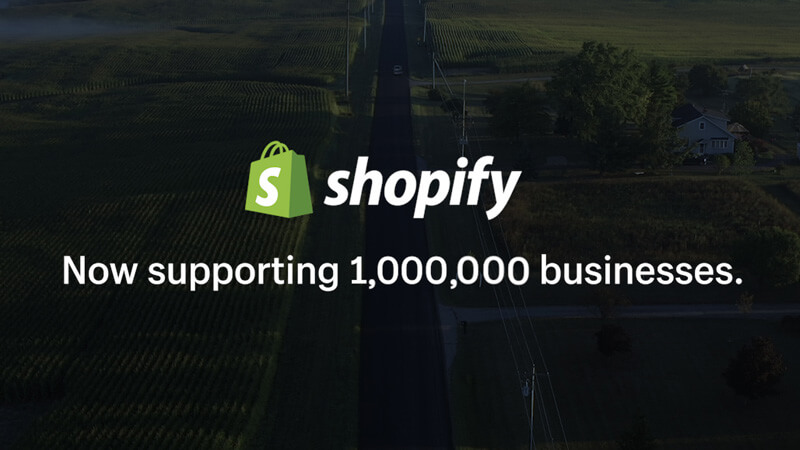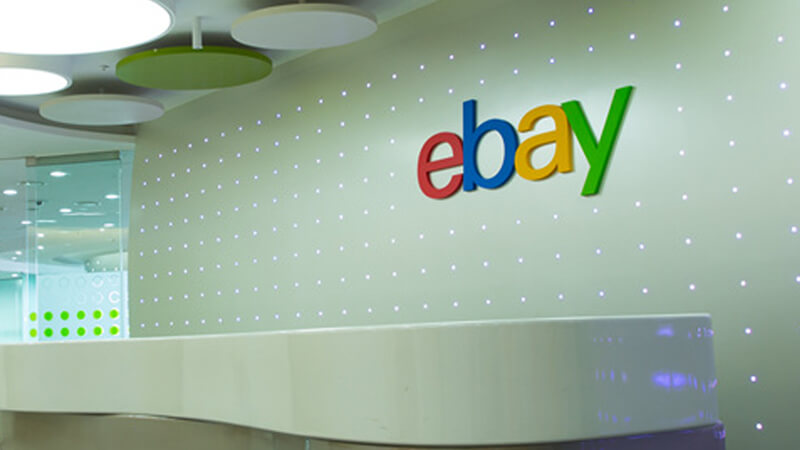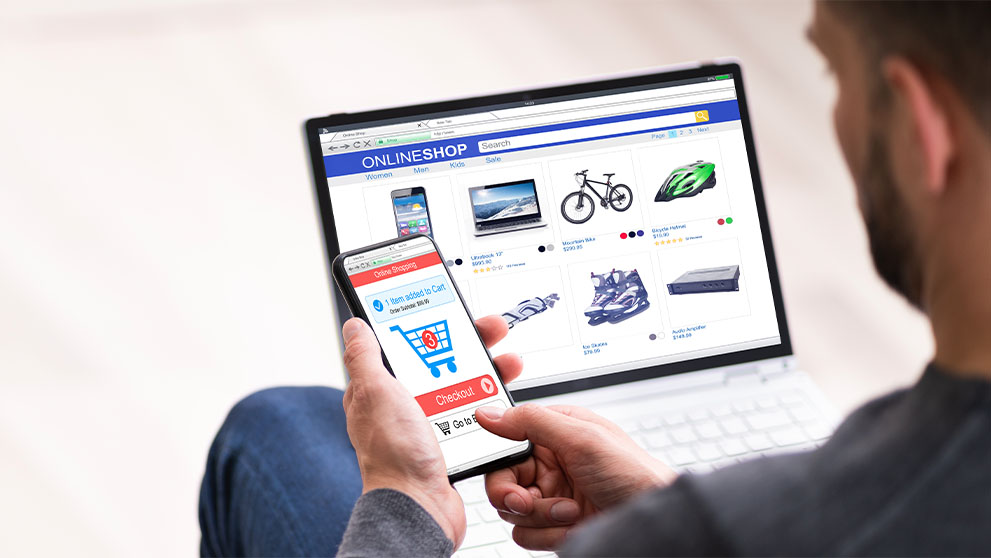Online marketplaces can connect your e-commerce business with millions of buyers across the world. But which one is right for you? Read on to discover the pros and cons of the world’s top platforms.

Amazon
Online marketplaces are big business – from local online marketplaces to marketplace giants such as Amazon and eBay. In 2019, more than 50% of all e-commerce sales were made through online marketplaces, contributing $1.7 trillion to the global economy.1
Even if you currently sell through your own e-commerce website, setting up an additional store on an online marketplace can expand your reach to millions more customers around the world. For minimal investment, you can benefit from the marketplace’s power – its visibility on search engines, its name recognition and its reputation. Plus, the marketplace will often handle the admin associated with fulfilling orders such as payment processing and returns – leaving you free to concentrate on other parts of your business.
But which one is right for your e-commerce business? We’ve collated the pros and cons of the leading platforms to help you decide the best online marketplaces for you.
Perhaps the most obvious place to start, Amazon2 is the largest e-commerce retailer by revenue in the world. But what can selling on Jeff Bezos's behemoth do for your business?
Pros
- Selling on Amazon means reaching millions of people. In the USA, there are over 200 million unique visitors per month3 and over 110 million Amazon Prime subscribers4, 20% of whom shop on Amazon a few times a week.5
- Nearly half of US product searches start on Amazon6 (even beating Google), meaning products listed on Amazon will be found by customers first.
- Amazon Marketplace is relatively easy to set up on, and its Fulfilment By Amazon service will handle inventory and delivery for you, including international shipping.
Cons
- Having an Amazon store is highly competitive – in the USA, more than 300,000 small and medium-sized businesses sell through Amazon Marketplace7. To cut through, your product will need a unique selling point (USP) or you may need to reduce your prices.
- In addition, further competition comes from Amazon itself, which sells its own products on the site.
- For businesses selling low-margin products, Amazon’s relatively high referral fees – averaging around 15% – will quickly eat into profits.
- Amazon Marketplace Partners are responsible for handling customer service issues themselves, so if you’re not in the position to resolve complaints quickly, your seller rating (and in turn, your sales) will suffer.

Alibabe / Tmall Global
As the largest e-commerce platform in China, you’ve probably heard of Alibaba8, a B2B business connecting wholesale exporters in China with countries around the world. But if you’re looking to sell to customers on a smaller scale, then Alibaba’s dedicated B2C platform, Tmall Global9, is what you need.
Pros
- As the biggest cross-border e-commerce platform in China, with 25% market share10, Tmall Global is your gateway into the lucrative Chinese market.
- Unlike its sister site Tmall.com11, Tmall Global is specifically set up for foreign brands – you don’t have to have a physical entity in China or a Chinese business license to sell on the platform, and you can accept payment in your local currency.
Cons
- Alibaba's Tmall Global prioritizes medium to large businesses: a seller’s annual sales must be more than USD$10 million, which prices out many SMEs.
- The seller must have locations for handling returns on the Chinese mainland.
- Though Tmall Global’s sales commission fee is relatively low – typically between 2-4% – the service fees can be steep and only redeemed if the seller hits certain sales targets.
- Before you even begin trading, you must provide a USD$25,000 security deposit, so cost of entry to this market is high.

WeChat Store
Continuing on from Tmall Global, another way to reach the vast Chinese market is through WeChat12, the country’s most popular messaging app, and a juggernaut of integrated e-commerce power. E-commerce businesses can sell on WeChat by connecting a mobile website to a WeChat Official Account. Sellers can collect payment from customers via WeChat Pay13, a mobile payment service incorporated on the platform.
Pros
- WeChat’s popularity isn’t limited to China – as of April 2020, it had over 1.1 billion monthly active users worldwide14, from a wide range of age groups15. So, whoever your target customers may be, chances are at least some of them will be using the platform.
- The convenience of WeChat Pay encourages spending – users simply connect it to their bank account and can then make purchases with a simple click on their phone.
- Sellers can segment their Official Account list of followers in order to target a particular group.
- You can send discounts directly to customers to keep them engaged with your brand.
Cons
- WeChat is primarily a messaging service; it doesn’t have organic traffic proactively searching for products as on other e-commerce sites. To attract customers, you’ll need to be prepared to spend on advertising and social marketing.
- The search box of WeChat is only receptive to specific keywords – again, you’ll need to invest in this area to ensure customers find your product pages.

Shopify's Shop
Shopify16 is best known for its suite of e-commerce tools that help businesses create their own online stores. In early 2020, Shopify launched 'Shop'17 , an app that better serves how customers like to shop by consolidating all sellers into one marketplace for customers to browse – much like Amazon. Customers can buy products and track orders directly on the app.
Pros
- Customers can follow their favorite Shopify stores on the app, and will be shown product recommendations from those brands first, so your products will be promoted to those who already love your brand.
- The app uses Shopify Pay for checkout, giving your customers a fast and easy payment process.
- Shopify have recently added focus to local stores, offering personalized recommendations and helping people discover local businesses - useful if you're looking to maximize your local reach.
Cons
- Customers can only view products from a single store at a time rather than search for products across multiple stores, like Amazon. This may reduce the impact of a key differentiator that makes you better than a competitor.
- Shopify Shop is currently limited to iOS and Android; there’s no web version available.

eBay
Browsing on eBay18 these days, it’s hard to believe that in its early years it was primarily an auction site which allowed users to bid on products. Nowadays, the site has more ‘buy it now’ items for sale – as of the third quarter of 2017, eBay reported 88% of its listings were from fixed price formats19. With over 168 million active buyers around the world20, it has a solid position as a leading marketplace.
Pros
- eBay’s global reach and trusted name mean many customers start their product searches there, putting products on the site in a better position to be found than independent e-commerce websites.
- eBay sellers keep an average of 5.13% more of their profits than if they sold the item on Amazon21.
- Sellers receive a certain number of free listings each month.
- eBay uses PayPal22, making it easy for sellers to accept payment in real-time and giving them all the security cover of the service.
- If you do choose to sell via the auction format, this can drive up your final sale price.
Cons
- eBay prioritizes sellers who can ship their items in 24 business hours or less – if they don’t, then their listings will have less visibility in the search results.
- In the US, if a seller’s eBay account doesn’t meet or exceed the minimum performance standards, the platform charges them additional fees when an item is sold.
- The platform offers upgrades to listings such as a larger gallery for photos, bold listings and themed layouts – all of which cost extra and can quickly add up.

Etsy
A more specialized platform, Etsy23 is the leading marketplace for selling handmade and vintage items. As with many e-commerce businesses, during the pandemic it saw increased activity, fuelled particularly by sales of homemade face masks (which generated $133 million in gross merchandise sales during the last quarter24). Masks aside, if you want to start making money from your hobby, selling on Etsy is a great place to start.
Pros
- A targeted customer base: Etsy is the go-to website for customers searching for unique and personalized gifts.
- Setting up a store is easy, and there are dedicated sellers handbooks and community forums for extra support.
- The site has a marketing tool, Etsy Ads, to help sellers run advertising campaigns, with useful analytics and SEO support to attract more customers.
- The mobile app makes it easy to communicate with customers and answer their questions on the go.
Cons
- Due to its popularity, the marketplace is pretty saturated. Even if you think you’re selling something unique, chances are there will be many similar products for sale. You’ll have to be creative to stand out!
- Not necessarily a negative, but be aware that Etsy is heavily skewed towards women and millennials - 81% of their customer base is female25. Obviously this can also be a pro depending on your target consumer!
Ultimately, the right marketplace for your e-commerce business is the one where your target customers are. So, how do you find them? Conducting a competitor analysis will help you identify how and where businesses like yours are reaching customers and thus a great indicator of which marketplace(s) you should be selling on. And you can use analytics tools such as SimilarWeb26 to find which marketplaces have a customer base that matches your target market. Read our competitor analysis guide for all the tips – with a FREE template to get you started.
DHL Express has easy integration options available for most of these marketplaces to support you with easy label creation and shipment visibility via their DHL Express Commerce solution. Apply for a DHL Express business international account for further guidance on helping your e-commerce business reach its global potential.
1 – WebRetailer, February 2020
2 – Amazon
3 – Statista, July 2019
4 – Statista, March 2020
5 – Oberlo, April 2020
6 – eMarketer, September 2018
7 – Forbes, April 2018
8 – Alibaba
9 – Tmall Global
10 – Alizila, January 2018
11 – Tmall.com
12 – WeChat
13 – WeChat Pay
14 – Statista, May 2020
15 – Statista, February 2020
16 – Shopify
17 – Shop
18 – eBay
19 – eCommerce Bytes, March 2018
20 – Small Business Trends, March 2018
21 – Crazy Lister, May 2018
22 – PayPal
23 – Etsy
24 – The Motley Fool, July 2020
25 - Etsy statistics & facts, Statista
26 – SimilarWeb


























